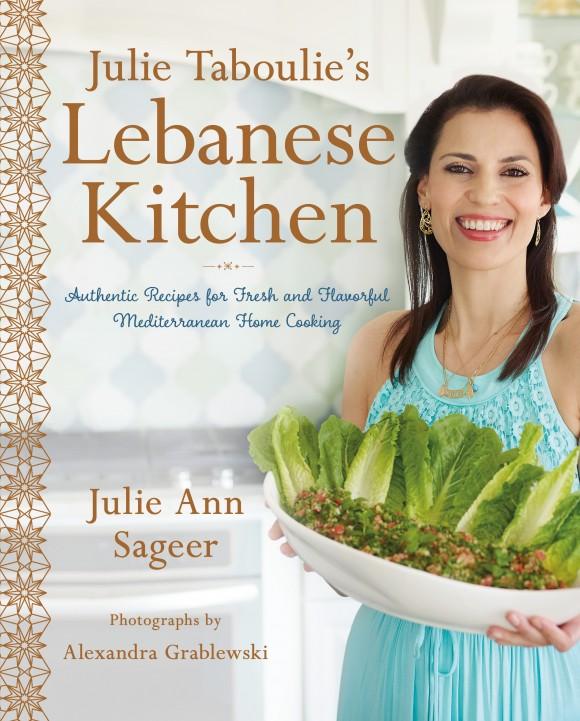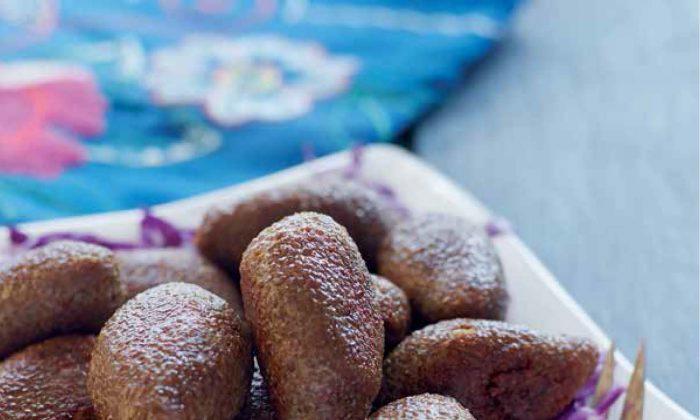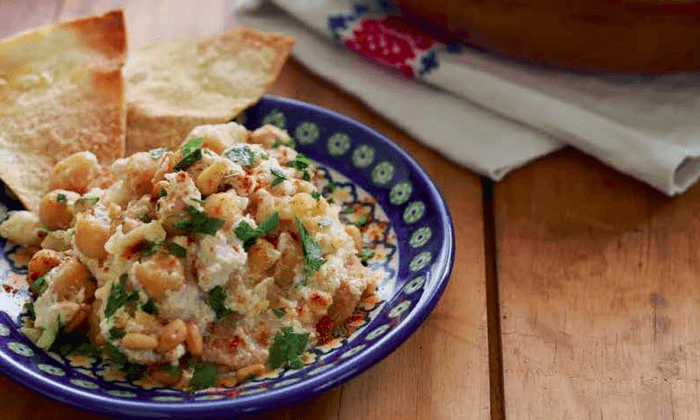Kibbeh Kbekib (Meat and Bulgur Spheres Stuffed With Lamb-Pine Nut Filling)
In Lebanese cuisine, any dish that combines cracked bulgur wheat and ground lamb is known as kibbeh. Kibbeh also has a number of different spellings, including kibbe and kibbee. This one is my absolute favorite; I can’t get enough of the out-of-this-world taste and texture of these addictive little nuggets.
Bulgur wheat is blended with ground lamb and onion and stuffed with heshwi, the traditional kibbeh stuffing of ground lamb, chopped herbs, spices, and buttery toasted pine nuts. Baked with butter, the end result is crispy on the outside, with a succulent, meaty filling inside. Paired with warm Khebez Arabi (the Lebanese version of pita bread) and a drizzle of Labneh (page 225), there’s really nothing more traditional or delicious.
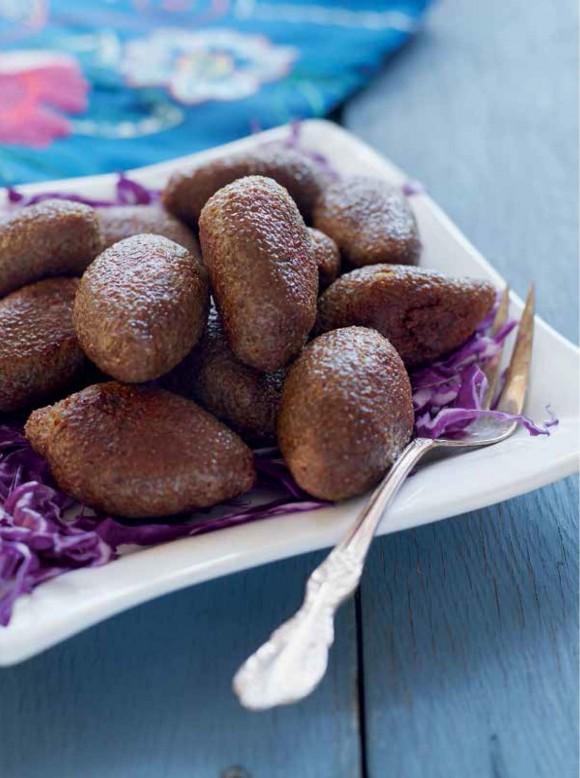
- 1/2 cup #1 fine bulgur wheat
- 1 small yellow onion, finely grated
- 1 pound finely ground lean lamb
- 1 teaspoon sea salt
- 1/2 teaspoon freshly ground black pepper
- 2 tablespoons extra-virgin olive oil
- 12 tablespoons unsalted butter (6 tablespoons cold and cut in halves)
- 2 tablespoons olive oil
- 1 medium yellow onion, finely diced (about 1/3 cup)
- 1/2 pound finely ground lamb
- 1 teaspoon sea salt
- 1/2 teaspoon freshly ground pepper
- 1/2 teaspoon ground allspice
- 1/3 cup fresh mint leaves, finely chopped
- 1/3 cup pine nuts
Preheat the oven to 425 F.
Make the heshwi: In a medium skillet over medium-high heat, melt 2 tablespoons of butter with 2 tablespoons of olive oil. Add the diced onions and cook until translucent. Add the ground lamb and sauté until it is completely browned and cooked through. Once the meat is cooked, season it with salt, pepper, and allspice. Remove from heat, add the chopped mint, and set aside to cool.
In a small sauté pan, melt 2 tablespoons of butter over medium-low heat. Add the pine nuts and toss to coat completely. Toast until they’re a light golden brown. Remove from heat and mix into the meat heshwi.
Make the kibbeh base: Place the bulgur wheat in a large bowl and lightly rinse with cold water to slightly moisten. Do not soak the bulgur wheat in the water. Add the grated onion and thoroughly mix to combine, then begin to knead the bulgur wheat mixture by pounding it with your fists.
In the bowl of a food processor, combine the lamb, salt, and pepper with a couple of ice cubes and pulse to thoroughly blend together. Once finely blended, transfer the mixture to a large freezer bag, smooth out the mixture to release any air pockets, and tightly seal and secure. Place in the freezer for about 10–15 minutes until ice cold but not frozen.
Remove the mixture from the freezer and add to the bulgur wheat mixture. Mix together so that all the ingredients are fully incorporated. Knead the mixture by pounding it together with your fists until it is soft and pliable but not mushy. If the mixture feels too stiff, gradually add small amounts of ice water to loosen.
Now it’s time to make the kibbeh spheres: Fill a small bowl with ice cubes and ice-cold water and set on the countertop. Then, place the heshwi next to the bowl with the kibbeh base. Coat a baking sheet with the 2 tablespoons softened butter and place it next to your work area.
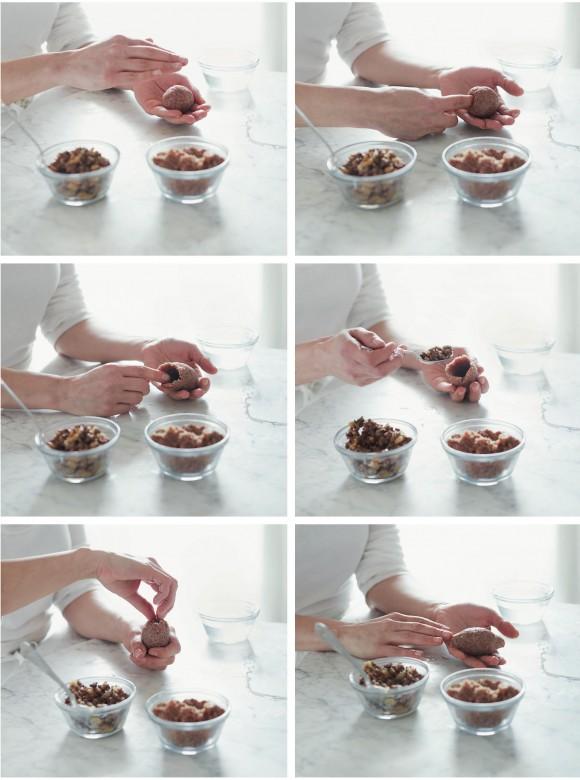
Lightly dip your hands in the cold water and take about 2 tablespoons of the kibbeh base and roll it into a small oval ball in the palms of your hands. Then place the oval ball in one hand, and, with your other hand, use your index finger to poke a small hole in one end of the oval, pointing inward to the middle. Now, gently begin to rotate your finger into the hole in a circular motion until you have created a deeper and wider hole within the kibbeh shell. Make sure not to break through the kibbeh walls or tear the outside. If you do, simply start over or seam it back together and smooth with your fingertips (see photos).
Now take about 1/2 tablespoon of the heshwi and fill the hole by slightly pressing it down into the bottom of the kibbeh ball and working your way up to about 1/4 inch from the top. Be careful not to overstuff. Close the hole by lightly dipping your fingers in the ice-cold water and tightly squeezing the opening ends together. Seam and smooth out the top tip and place on the buttered baking sheet. Repeat this technique with the remaining base and filling; you should have between 10 and 14 kibbeh.
Next, place one of the halves of cold butter onto the top of each kibbeh sphere. Bake for approximately 30 minutes, turning the spheres over halfway through. They should be golden brown and crispy on the outside. Remove from the oven and lightly shake the pan back and forth to roll the kibbeh balls around with the baking juices and butter.
Serve straight out of the oven with labneh, drizzled with olive oil, sea salt, and chopped mint leaves, and with warm khebez arabi.
Laban (Unstrained Lebanese Yogurt)
Laban simply means “white” in Arabic, and this ever-present Lebanese dairy product has been made since biblical times and probably before. In its unstrained form, laban is silky and shiny, and usually made with cow’s milk. Laban is used in myriad Lebanese recipes from soups to salads to desserts, and can also be eaten as you would any other yogurt.
Makes 15 cups (almost 1 gallon)
- 1 gallon freshly purchased milk (whole, 2 percent, or nonfat skim), at room temperature
- 5 tablespoons whole-milk plain yogurt, at room temperature (I prefer Dannon)
Pour the milk into a large, heavy-bottomed pot and place over medium heat. Slowly bring it to a steady simmer without stirring and without bringing it to a boil. Watch carefully to prevent boiling or scalding. After 25 to 30 minutes, the milk will foam and start to slowly rise up the sides of the pot, 1/2 to 1 inch above the original milk level. Once this happens, immediately remove the milk from the heat and let cool.
After the milk has cooled for about 1 1/2 hours, test the temperature, either with a thermometer—it should register 95 F—or by holding your pinky finger in the center of the pot for 10 full seconds. If it is too hot to keep your finger in, the milk hasn’t adequately cooled.
Spoon the yogurt into a small bowl and stir until smooth. Slowly ladle in 1 cup of the warm milk, stirring continuously to incorporate the milk into the yogurt completely. Pour this mixture into the center of the pot of milk and slowly stir the warm milk, working your way from the bottom to the top of the pot, and all around. Do not scrape the bottom of the pot and do not overstir.
Cover the pot with a lid, and wrap the covered pot with large kitchen towels. Leave the pot at room temperature, undisturbed, for at least 12 and no more than 24 hours.
After the time has elapsed, unwrap the towels and immediately transfer the pot to the refrigerator to chill the laban for at least 6 hours and ideally 12, before eating or using for cooking.
Taboulie Tip! Make sure to purchase and use the milk on the same day; it’s highly important that the milk should be very fresh when making laban!
Reprinted from “Julie Taboulie’s Lebanese Kitchen: Authentic Recipes for Fresh and Flavorful Mediterranean Home Cooking” by Julie Ann Sageer. Published by St. Martin’s Griffin.
